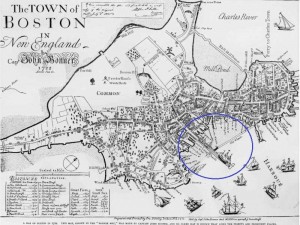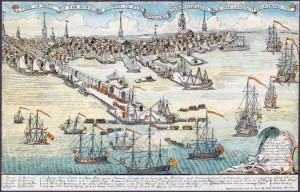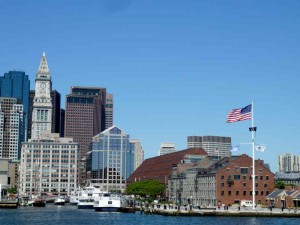Select your language to auto-translate:
From the beginning, Boston was a town linked to the sea, with its success dependent on maritime trade and industry. And, its most important gateway to the sea in colonial times was Long Wharf. Originally called Boston Pier, Long Wharf construction began in 1711 (when Boston was the largest city in the Colonies), completed by 1715, and at its peak was almost 1,600 feet in length, 54 feet wide, and capable of docking up to 50 vessels. It was, by far, the largest and most significant wharf in Boston and was to play a major role in Boston’s economic and Revolutionary history.
The heart of Colonial Boston was the Town House, Boston’s official town hall, which was at the base of King Street (King Street’s name was changed to State Street after the Revolution). The first Town House was built in 1657 and burned down during the Great Fire of 1711. It was replaced by the current “Old State House” in 1713, and was the location for the British Government until they evacuated Boston 1776. From the Town House, a viewer could look directly down King Street to the end of Long Wharf, see ships coming and going, and keep the pulse of the town.
As illustrated in the famous Paul Revere engraving above, British Troops landed on Long Wharf to help enforce the Townshend Acts in 1768. The oldest structure remaining on Long Wharf today, dating from around 1760 is a building that served as John Hancock’s “counting house” (primary place of business), who in, addition to being the famous signer of the Declaration of Independence, was one of the richest men and a leading merchant in Boston. Today John Hancock’s counting house is the Chart House restaurant.
British troops departed from Long Wharf when they left Boston in March of 1776. It was the landing place for the ship from Philadelphia bringing the Declaration of Independence (first read to the citizens from the balcony of the Old State House on July 18the 1776), privateers and blockade runners sailed from its docks, and its warehouses held military stores.
Today, Long Wharf is a great place to gather tourist information, take cruises of the harbor, and is the docking location for the water shuttles to the harbor islands and the Charlestown Navy Yard (USS Constitution). For an excellent posting on Long Wharf from a series by the National Park Service on maritime Boston, click here. The Aquarium is located at the end of Long Wharf.


























[…] Long Wharf post describing Long Wharf’s major contribution to early Boston. Also,where you will catch the highly recommended water shuttle to Charlestown. […]